How has COVID-19 changed the best ways to help animals? Lewis Bollard, Open Philanthropy’s Program Officer for farm animal welfare, explores the new challenges and opportunities in corporate campaigns, political advocacy, and meat alternatives.
We’ve lightly edited this talk for clarity. You can also watch it on YouTube and read it on effectivealtruism.org.
The Talk
Nathan Labenz (Moderator): Hello, and welcome to this session on doing the most good for animals post-COVID-19, with Lewis Bollard. Following a 15-minute talk by Lewis, we'll move on to a live Q&A session, where he will respond to your questions. [...]
Now I would like to introduce our speaker for this session. Lewis Bollard leads Open Philanthropy’s strategy for farm animal welfare. Prior to joining Open Philanthropy, he worked as Policy Advisor and International Liaison to the CEO at the Humane Society of the United States. Prior to that, he was a litigation fellow, a law student, and an associate consultant at Bain & Company. He has a BA from Harvard University in social studies and a J.D. from Yale Law School. Here's Lewis Bollard.
Lewis: Hi, thanks for joining, everyone. With the world changing and upending around us, I've been thinking a lot about how the present crisis should affect how we think about the most effective ways to help animals — particularly farm animals. I definitely don't have all of the answers. But I'm excited to explore what this present moment could mean for the [animal welfare movement].
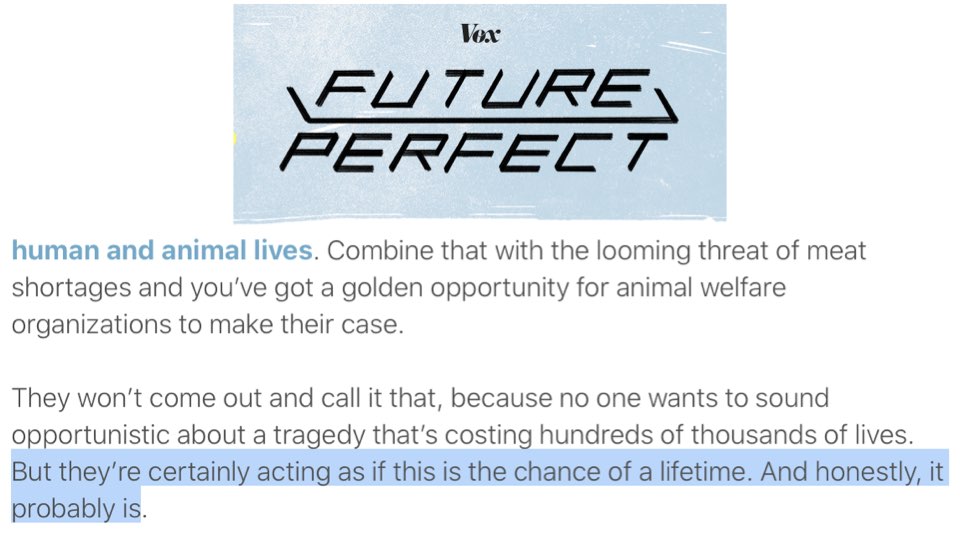
As is often the case, I think that the Vox Future Perfect newsletter has put it most succinctly and clearly: They suggested a few weeks ago that now might be a golden opportunity to help animals. I've heard people mention several different approaches that groups might take; today, I’ll consider the pros and cons of some of them. I’ll focus on a few things that we need to be careful of, as well as some that might present unique opportunities.
Potential opportunity No. 1: Push to shut or slow down slaughterhouses
The first approach that many [farm animal advocates] are discussing is working to shut or slow down slaughterhouses, at least temporarily. There’s a very clear public health basis for this.
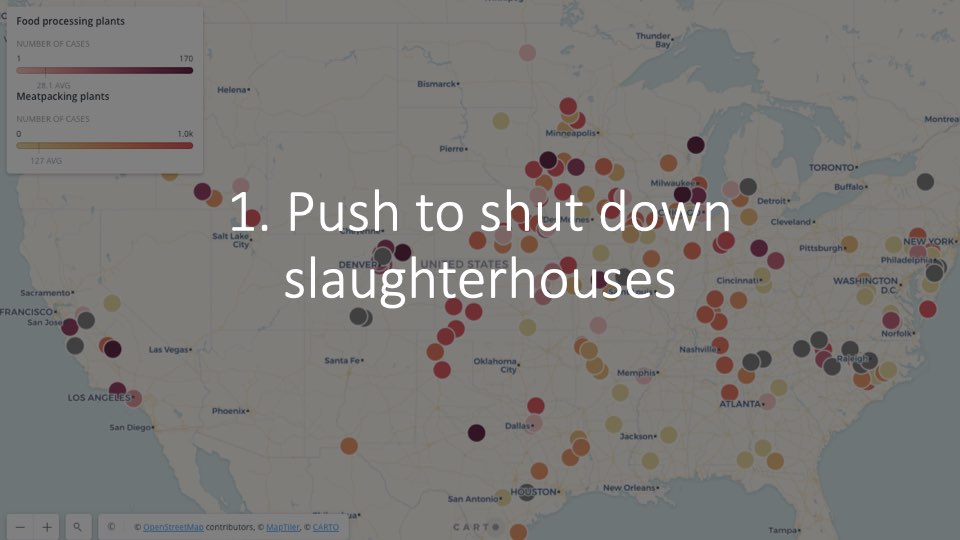
This map shows slaughterhouses and food processing plants with COVID outbreaks across the US. [As of June 2020], there have been over 223 meat plants alone with COVID outbreaks, infecting about 25,000, or one in three, of the meat industry’s workers. It's an astounding number. I'm sure that there would be real public health benefits to slowing or shutting down slaughterhouses.
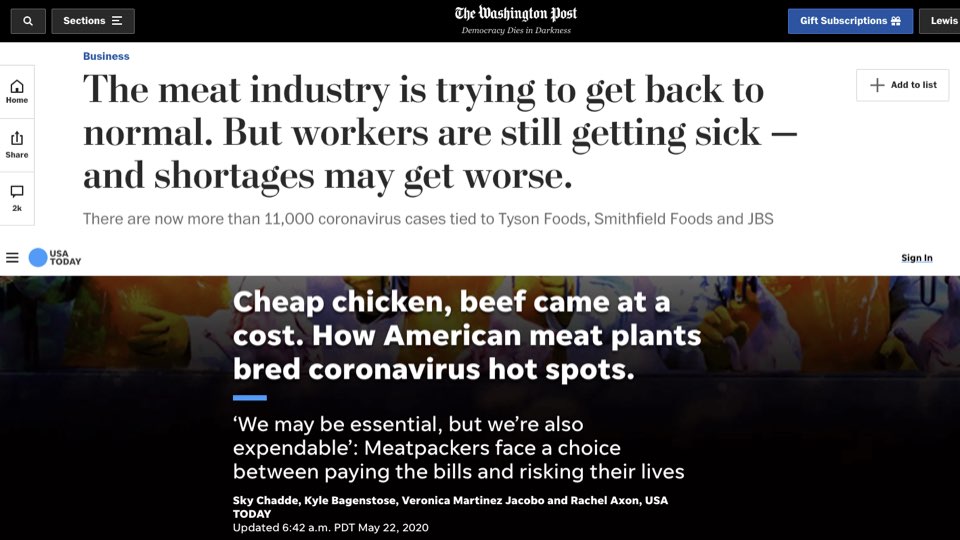
There would also likely be benefits for workers. The plight of slaughterhouse workers is finally receiving the kind of media attention that it has deserved for a very long time, which is great to see.
The question for us as animal advocates, of course, is: Would [this kind of push] be good for animals?
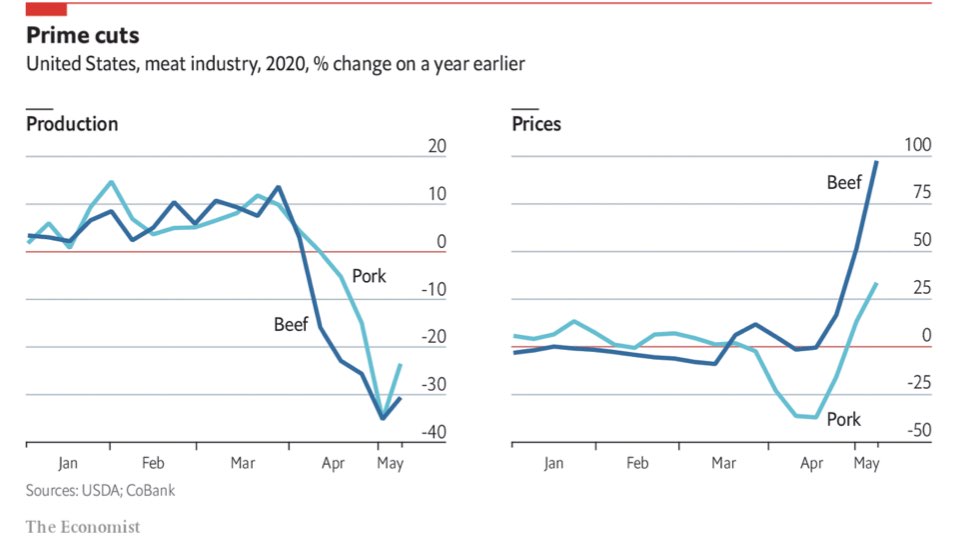
I have seen advocates pointing to data like [the graph above] to suggest that there may be a bigger opportunity here — one that would strike at the heart of the industrial system to pursue systemic change. Are they right? Sadly, I don't think so.
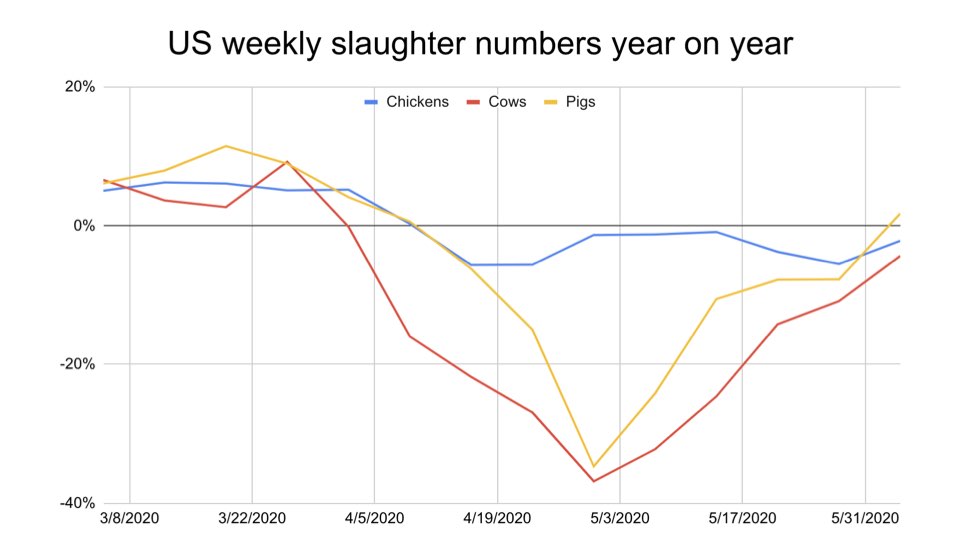
This graph picks up where the last one ended and includes chickens. It charts the number of animals being slaughtered in the US on a weekly basis relative to the same week last year. As you can see, US slaughter numbers never really dipped for chickens — and while they did decrease for cows and pigs, they're actually back to normal. That's similar to what we've seen in China, Europe, and elsewhere around the world.
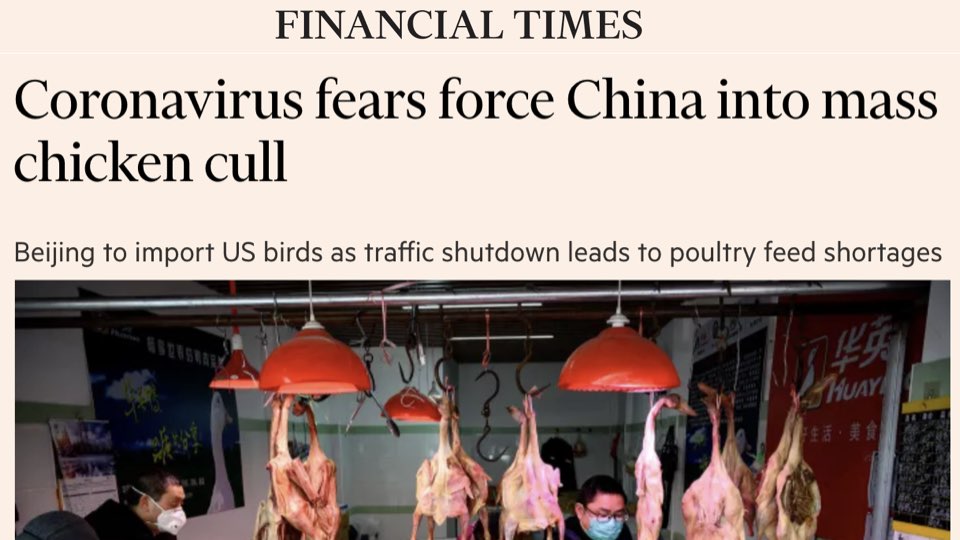
More slaughterhouse shutdowns — and even slowdowns — are, sadly, very bad for animals. Since farmers already raise too many animals in a confined space and don't plan much in advance for crises like this, shutdowns result in a lot of animals that have nowhere to go. We've seen mass cullings of these animals in China, India, Iran, the US, and increasingly in Europe.
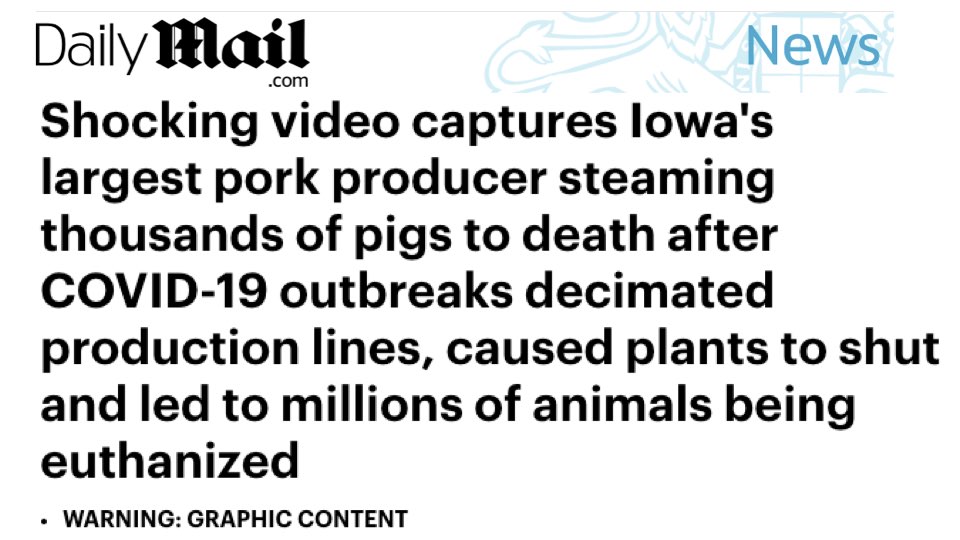
This headline from the Daily Mail shows why this matters. It’s about a Direct Action Everywhere investigation of a pig farm in Iowa, where they found that the workers were using a method called “ventilation shutdown.” They literally just turn off the ventilators, pump in additional heat, and wait for the pigs to expire from the heat. That took hours.
The reason why farmers practice such horrendously cruel methods — which also include the use of live burial in China, Iran, and other countries — is because these farmers have far too many animals to provide individual care to, or [kill individually]. So the best-case scenario you can hope for is that they use an inert gas [transcriber’s note: inert gas causes less pain than many other ways of killing animals]. Very few farmers, though, are willing to pay for inert gases; they are relatively expensive. Therefore, they resort to these cruel killings.
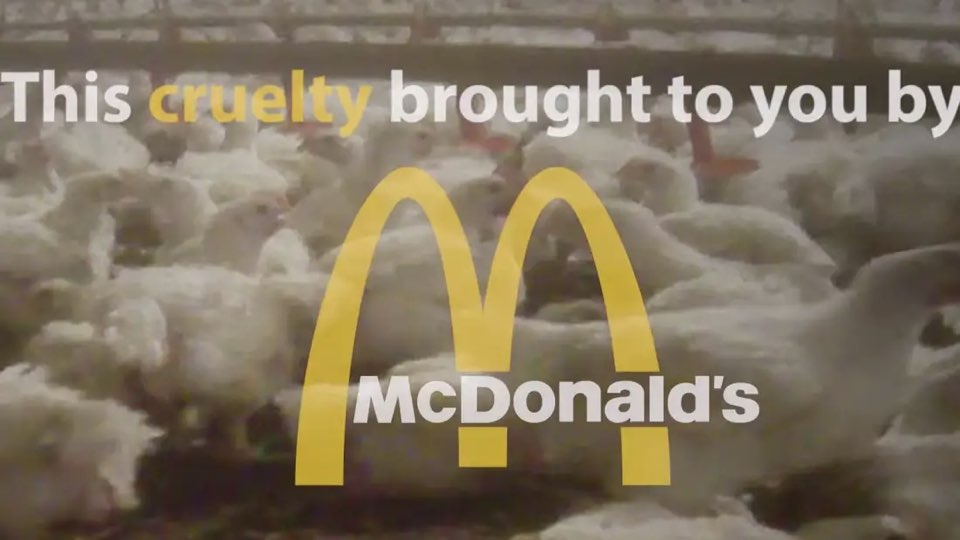
I do think that there may be an opportunity to tie [together] this particularly horrendous cruelty, the mistreatment of workers, and the public health threats to the brands that buy the meat industry’s products. For example, McDonald's is likely Tyson Foods’ largest customer. There's a Tyson VP who manages the McDonald's relationship. We've seen throughout this crisis that Tyson has been perhaps the worst impacted. They’ve had the highest number of COVID fatalities and actively lobbied the president to reopen plants when it wasn't safe to do so. Also, as we've seen for years, there’s evidence of animal cruelty at Tyson plants. So, this may be an opportunity to tie [these issues] more closely to brands like McDonald's that rely on Tyson as a supplier.
Potential opportunity No. 2: Publicize the connection between pandemics and factory farming
The second opportunity under discussion is around publicizing the connection between pandemics and factory farming.
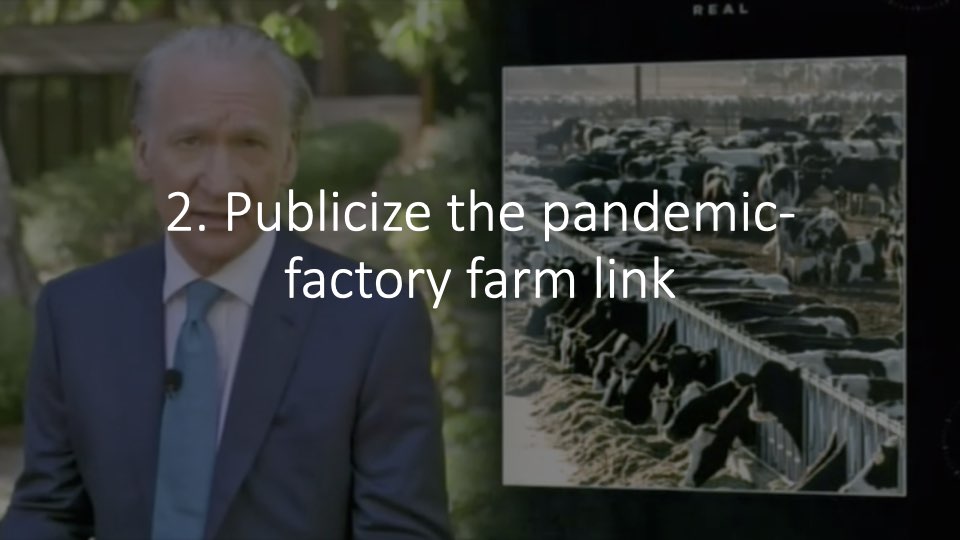
Here is an image from Bill Maher's HBO show, where he talked about the way in which factory farms — by confining a lot of immunosuppressed animals with identical genetics into a very small space — create the perfect breeding ground for a pandemic.
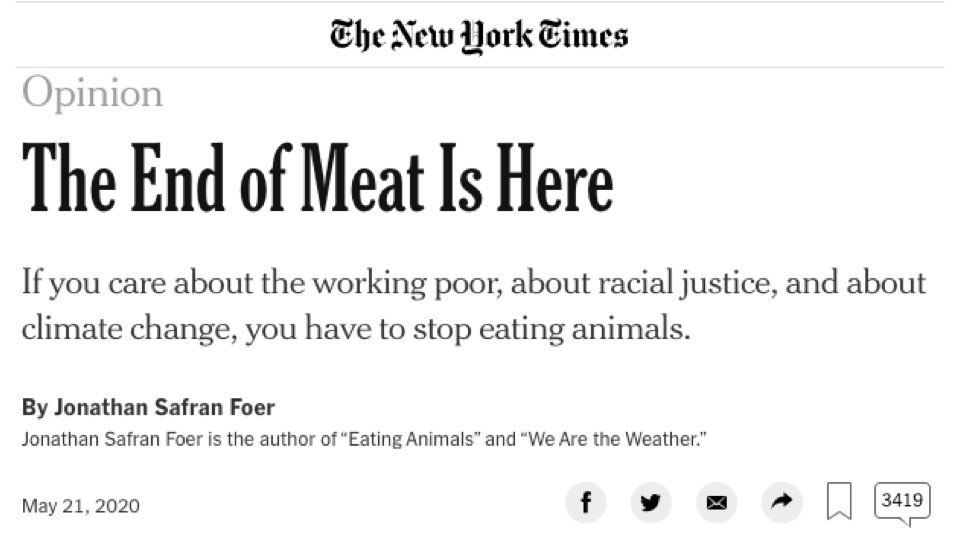
This was also part of the hook for this New York Times op ed last month by Jonathan Safran Foer. You can see he received a lot of engagement in the comments. It was also trending on Twitter for a while. And I think it's certainly quite possible that this messaging has an ability to reach new audiences and to get media attention that we wouldn't receive with a traditional animal-focused factory farming message. But in spite of the publicity, there's little evidence to date that people are making the connection between pandemics and factory farming.
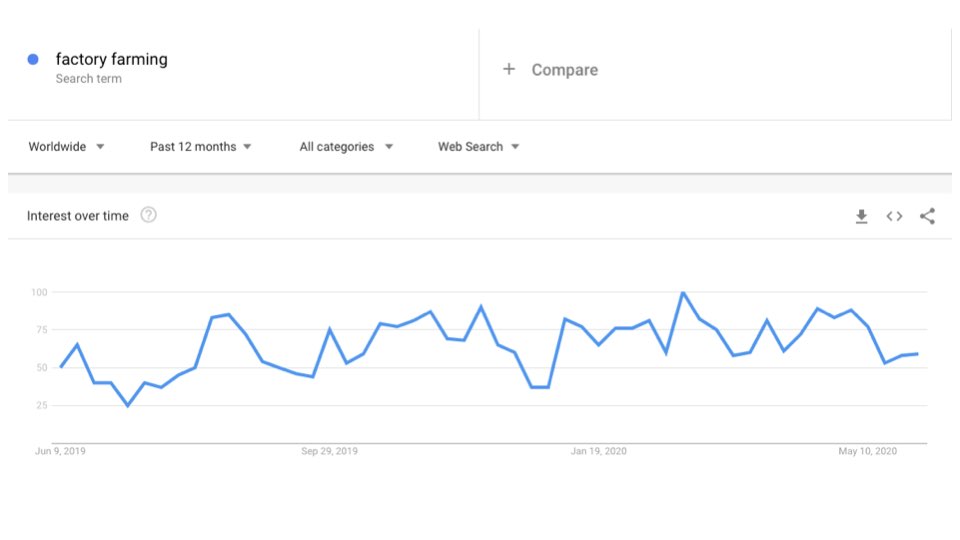
Here are Google Trends data on global searches for factory farming. The results are the same for the US and other large markets. They’re different if you look for the topic of animal farming, but that appears to be because in Portuguese, lockdowns are miscategorized as part of the topic; therefore, you see a huge spike due to that.
There’s little evidence of a [meaningful] uptick in public concern around factory farming, which might be surprising to those of us who are on Twitter, where we constantly see posts from our friends and other people in the animal movement. This is a good reminder that we are sometimes in a news bubble as far as this information is concerned.
There are also some risks [that come with publicizing the connection between pandemics and factory farming].
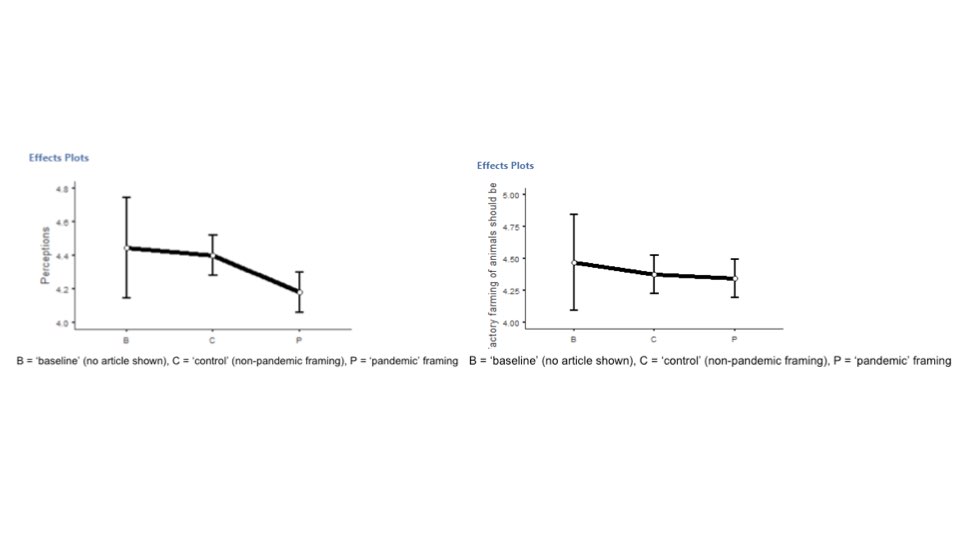
This rather poorly put-together slide shows two graphs from a recent Rethink Priorities survey in which they asked American adults about (1) their perceptions of animal activists and (2) their support for a ban on factory farming. What they found was that exposing people to a message linking pandemics and factory farming not only did no better than a control message (i.e., just mentioning factory farming as a baseline) or providing no message at all. The first approach actually did slightly worse in terms of support for ending factory farming, and substantially worse in terms of its effect on perceptions of animal advocates as accurate and truthful.
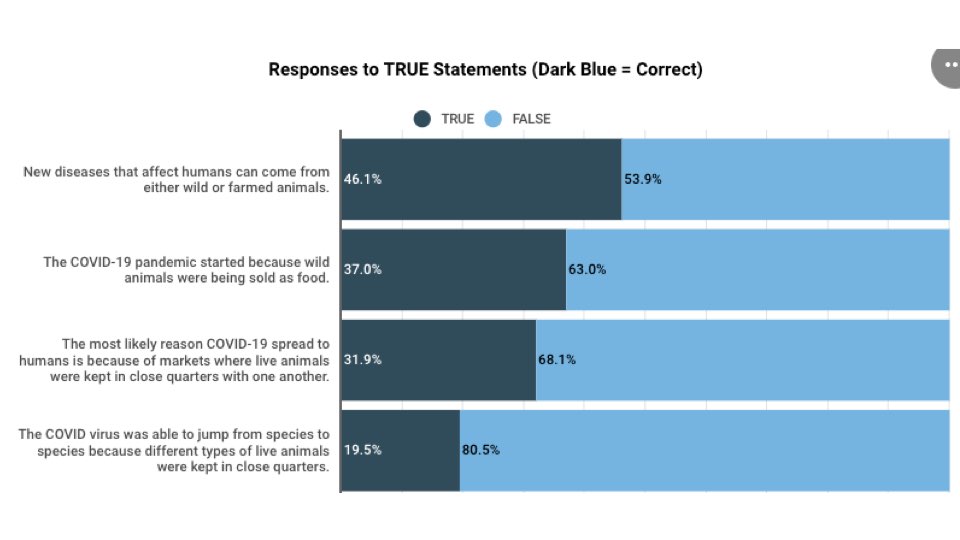
I think this chart helps to explain why. This is from another survey of American adults. It was done by Faunalytics [in spring 2020]. They read people a series of factual statements about the connections between COVID or pandemics in animals. As you can see, most people rated those factual statements as false. Perhaps even more strikingly, when the researchers asked people an open-ended question — “What caused COVID to jump from animals to humans?” — only 16% of people mentioned live animal markets, which is the current scientific consensus answer to how that jump likely happened. Therefore, people don't even connect COVID or pandemics to animals, let alone to factory farming.
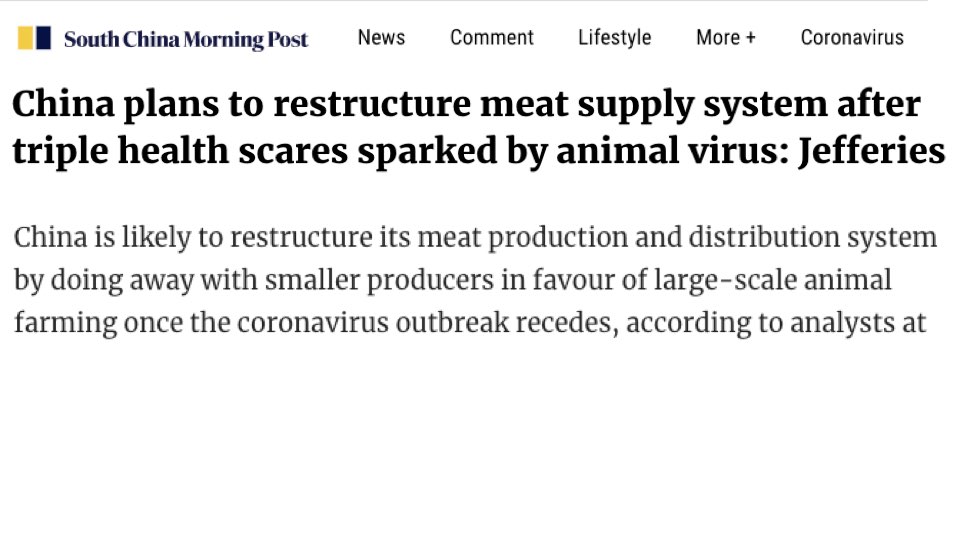
Here's another risk of pandemic messaging: We’re seeing a policy response from China, where the government is responding to the threat of zoonosis by pushing for greater consolidation within large factory farms, which they perceive to be both more biologically secure and easier to monitor than the many higher-welfare, small backyard farms that have traditionally been dominant in China. I think this trend is inevitable for many reasons, but it's still not something we want to actively speed up.
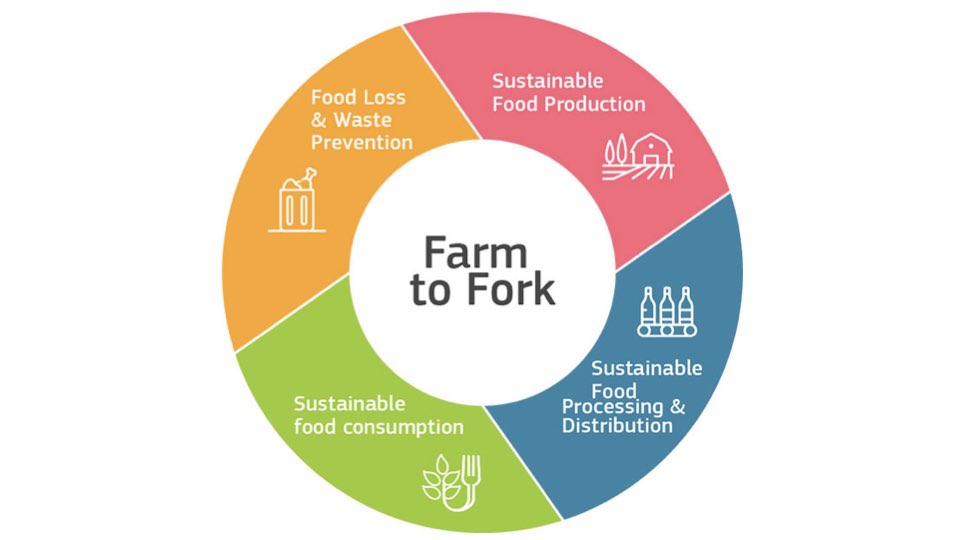
However, I do think there's some positive potential here. First, there’s the new EU Farm to Fork strategy, which specifically mentions that COVID-19 demonstrates the fragility of the current industrial agriculture system and calls for more sustainable alternatives. More specifically, the plan calls for more funding for the development of plant-based alternatives and for higher animal welfare standards.
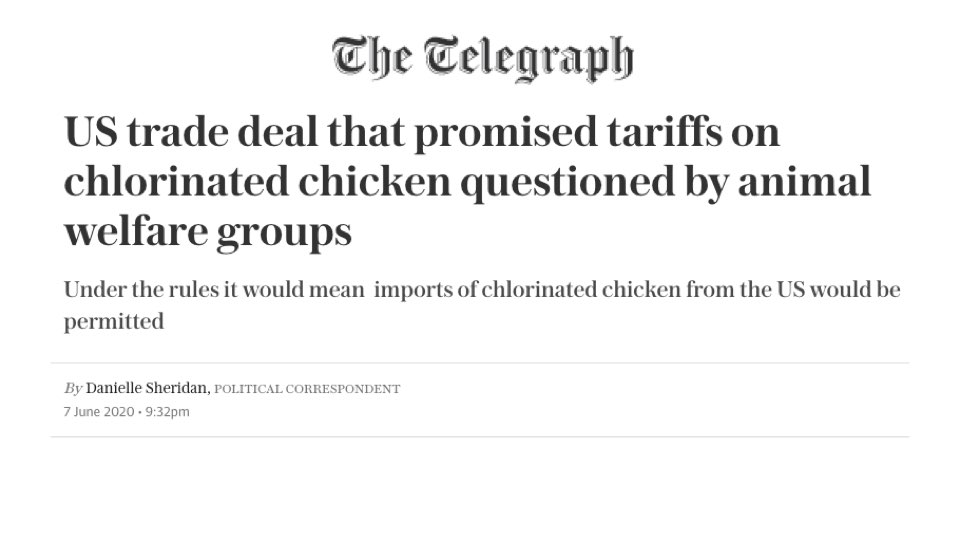
Also, I think there might be opportunities to cover food safety and its connection to animal welfare more broadly. This connection isn't always direct. For example, in the current UK-US trade negotiations, chlorinated chicken has become a major concern to the UK public, seemingly based on fairly ill-founded concerns. But there are some real animal welfare concerns — namely, that the use of chlorine by US slaughterhouses allows US chicken producers to maintain poor hygiene standards. In particular, they don’t have to change the litter that the birds leave between flocks, as European producers do. This likely leads to birds getting more burns and blisters from the reused litter, which in turn causes pain and creates major welfare problems.
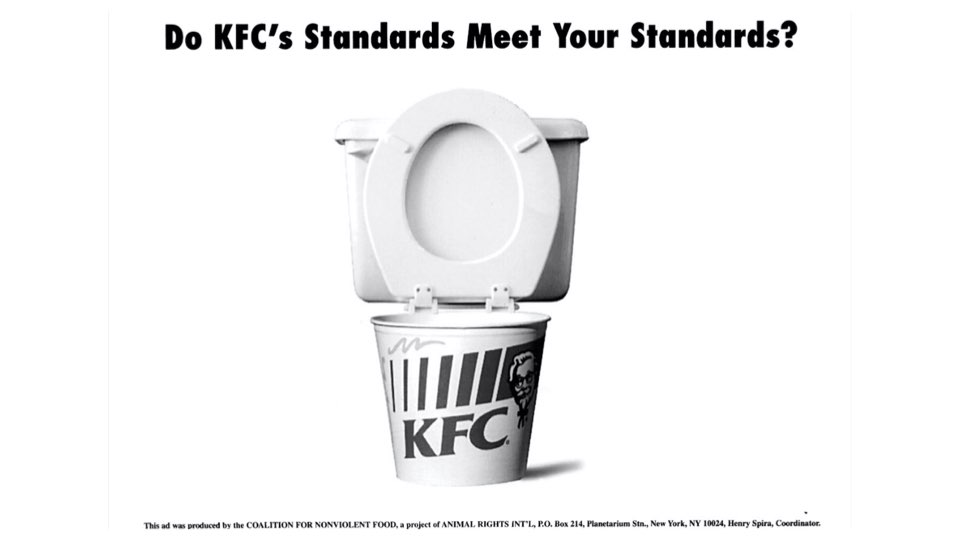
For this slide, I mainly just wanted to show this image. I came across it the other day when I was rereading Peter Singer's excellent biography of Henry Spira, Ethics into Action, which I highly recommend if you haven't had a chance to read it yet. Henry Spira was an early effective animal activist. He focused on corporate campaigns. And this was a creative image that he had commissioned as part of a campaign against KFC in the 1990s. Now, despite the tenuous connection to my topic, I do think that it's worth considering that food safety may play a bigger role in animal welfare campaigns going forward.
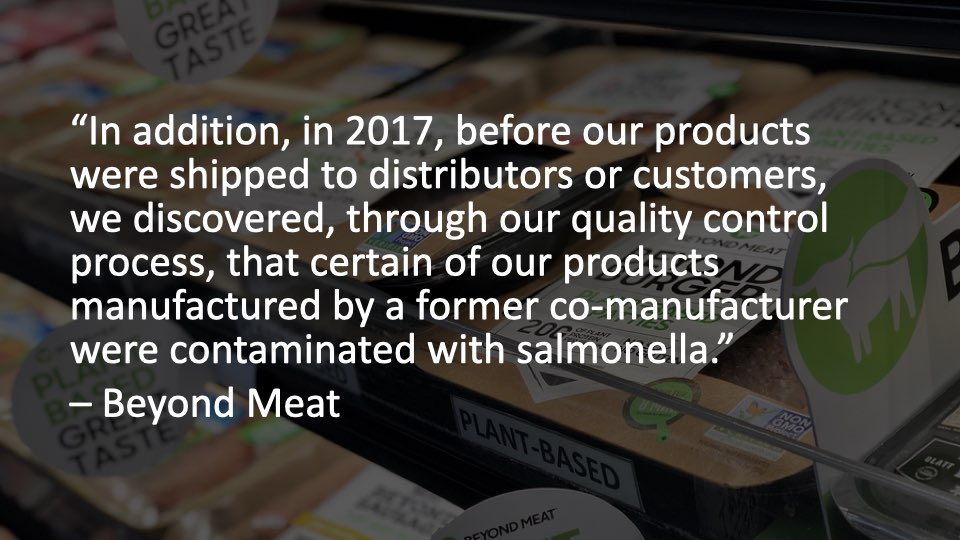
For example, I think there's an opportunity for plant-based meat companies to highlight the safety of their food products. I was really struck by this quote that I came across in the Beyond Meat IPO [initial public offering] filings with the SEC last year. Beyond Meat called out one incident in 2017: Before any products made it out the door at one of their co-manufacturing facilities, some products were infected with salmonella.
I find this striking because Beyond Meat treated it as a big deal, recalling the product and even canceling the co-manufacturer's contract. By contrast, if a conventional US chicken producer recalled all products infected with salmonella, they would have very few products to sell. The US Department of Agriculture’s safety target is that less than 15% of US chicken still has salmonella when it leaves the plant. There’s a real difference between the safety standards that plant-based meat is holding itself to versus those that the meat industry has been accustomed to following.
Potential opportunity No. 3: Promoting plant-based meats
That brings us to the third and final opportunity around the current situation, which is promoting plant-based meats as a potential solution to the fragility of the current industrial animal agriculture system.
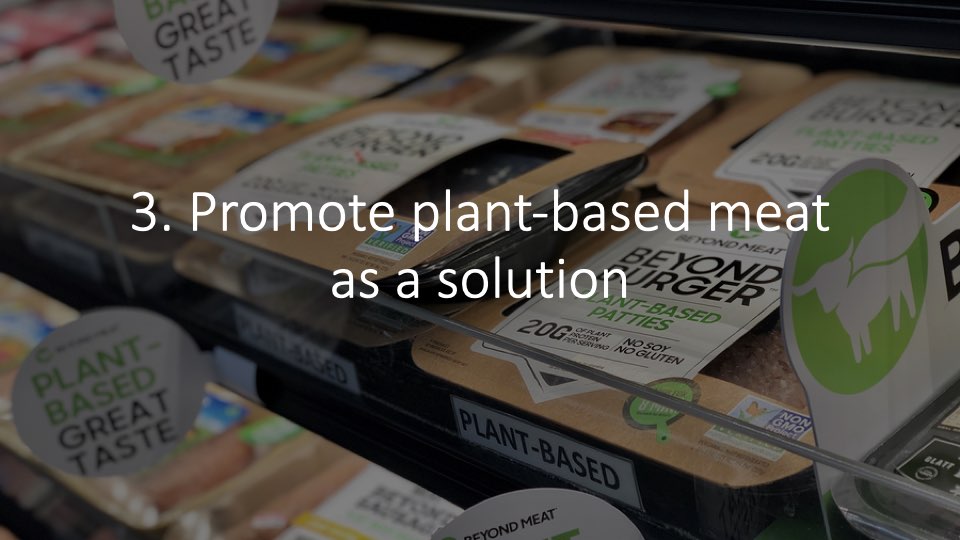
Plant-based meat facilities have had no recorded COVID outbreaks to date. That’s probably because they're highly automated. Also, they've continued to be able to stock the shelves, where meat producers have often failed.
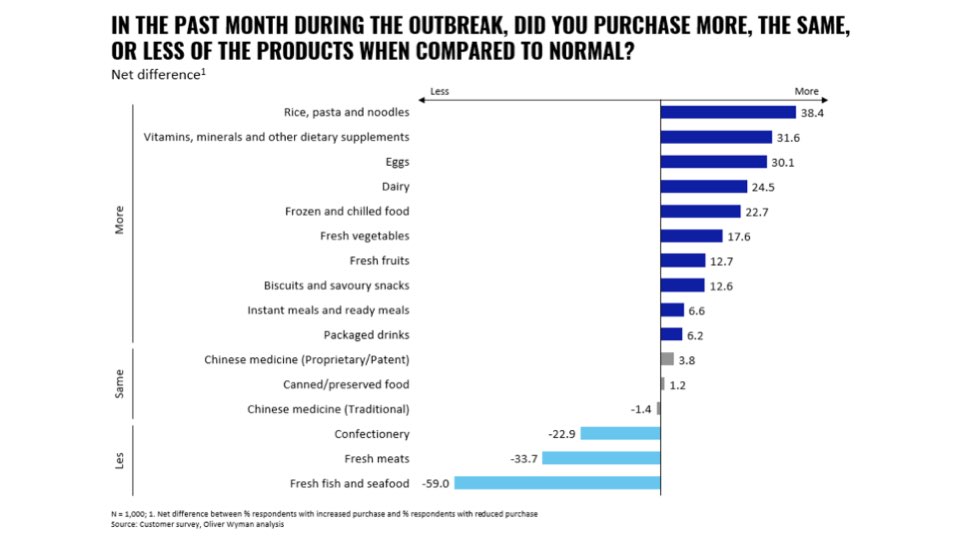
There's also some evidence from China that people switched to more plant-based options during the crisis, as the chart [above] suggests. It's hard to know, based on scanned media reports, whether this was due to a scarce supply of meat or consumer concerns around its safety. But either way, I think it emphasizes the vulnerability of meat to this crisis and the greater resilience of plant-based foods.
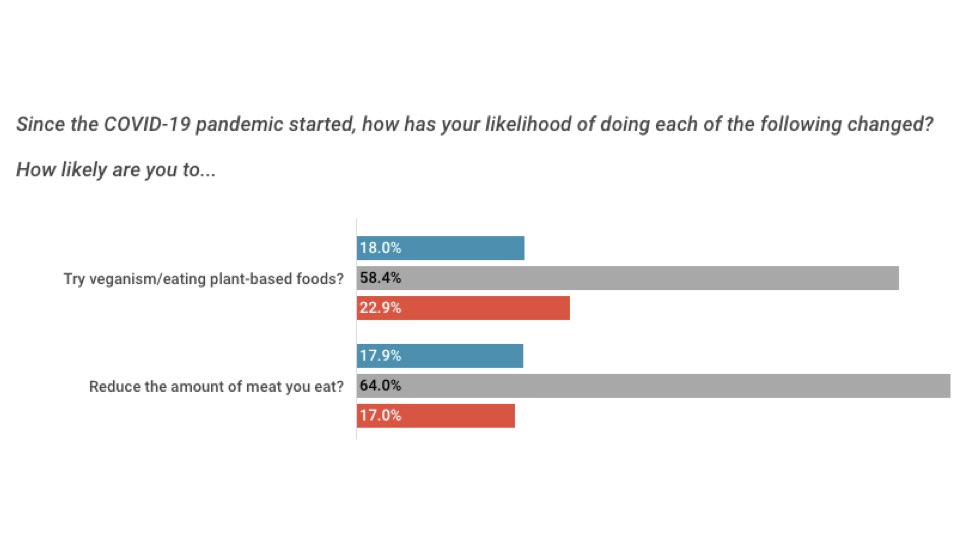
Still, we shouldn't get ahead of ourselves. These data are from the same Faunalytics survey that I mentioned earlier. The blue bars indicate “more likely,” red indicates “less likely,” and gray indicates “neutral.” And the responses are very similar to what we see during normal times, which is roughly the same number of Americans saying that they plan to eat more meat or less meat, and more plant-based foods or less plant-based foods. So again, we shouldn't [expect] a big change in consumption.
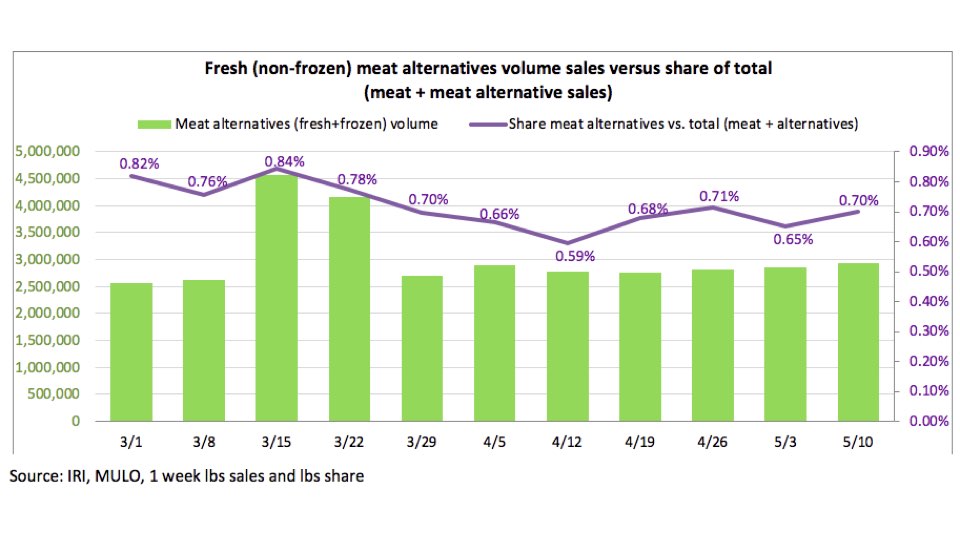
This piece of data is also consistent with that finding. It shows US retail sales of plant-based meat in green, and the percentage of plant-based meat’s total meat market share in purple. You can see that the plant-based meat sales have been going very strong. But perhaps surprisingly, its market share is actually down slightly. So we're not seeing a huge market takeover.
That said, I still think this is an impressive result for plant-based meat, given that the leading brands — Beyond Meat and Impossible Meats — were almost entirely reliant on food service prior to this crisis. So, it's impressive that they are holding steady in the retail category.
I think we are starting to see some exciting new partnerships and launches come out of this. For instance, just within the last month, Beyond Meat has rolled out a new product with Yum Foods in Starbucks stores in China.

This is an advertisement for a Pizza Hut Beyond Meat product in China — another major distributor. I'm hopeful that we'll start to see more such partnerships.
I look forward to your questions. Thank you.
Q&A
Nathan: Thank you, Lewis, for that talk. Great job. We've already had a number of questions submitted, so let's get started.
Lewis, welcome live to EAGxVirtual.
Lewis: Thanks, Nathan. And hi, everyone.
Nathan: Awesome. Let's get started. Do you think there should be more emphasis on the health and well-being of the workers in these industries, because that could potentially be easier for the general public to understand and latch onto?
Lewis: Yes, for the sake of the workers, there should certainly be more attention to their plight. I think this has been overlooked for far too long, and it is certainly easier for the public to relate to. We've seen the media pay far more attention to it than we normally see to the plight of animals within factory farms or slaughterhouses, or to the mass killings of farm animals going on currently. I think it's good that there's attention for workers. And I think it's true that it gets more attention.
Unfortunately, the solutions for animals that we want don't tend to be the same [as the solutions workers want]. So I think it's independently good to have workers' rights reforms. In terms of changes that will make a real difference for workers, my sense is that spacing people out could certainly help animals, and slowing down the line might help animals a bit. But otherwise, reforms like maintaining better sanitation methods are good ideas for workers, but probably won't accomplish much for animals.
I do think that as animal advocates first, we also need to keep thinking about the consequences of different actions for animals. I certainly think people should do things to help workers as well. But I'm not sure there is going to be a silver bullet that simultaneously helps animals as much.
Nathan: Thank you. That's too bad, but it makes sense.
When a general audience talks about reasons to not eat meat or to eat less meat, they often cite environmentalism or personal health benefits. But those are not, obviously, fundamentally about animals. How concerned are you that technological advancement could render those concerns — environmentalism and personal health — ultimately ineffective as arguments against the consumption of animals?
Lewis: I've always had mixed [emotions] about the environmental and health arguments. I think there are a few limitations to them. Clearly, they work for some people, so I don't mean to say that people shouldn't reduce their meat intake or go vegan for health for environmental reasons.
However, I think one problem is that they focus on individual consumer choices, whereas I think we want to frame the issue more as a social movement and a moral imperative.
Another risk is that for a lot of people, environmental and health reasons lead them away from red meat and toward white meat — chicken and fish — which probably are healthier and probably have a smaller environmental footprint, but are much worse in terms of animal cruelty. On those grounds, I’m already worried.
In terms of the potential of technological advancements that reduce emissions from animal agriculture or improve nutrition, yes, I think those could further weaken the environmental and health arguments for [eliminating or decreasing meat consumption]. But I guess I have always found those arguments weak. All else being equal (which I know isn’t always the case), I think we should try to put the message about animals’ well-being and suffering first.
Nathan: Thank you. How worried do you think the animal advocacy movement should be about making a bad impression for potentially trying to capitalize on the COVID-19 pandemic and all of the attendant hardship and tragedy that has come with it? How can we push the issue, but still seem genuine and not alienate the public?
Lewis: I think that's a really good question — one that I'm genuinely unsure about. I think there are different philosophies on it within the movement. The attitude of a group like the People for the Ethical Treatment of Animals is very much that all publicity is good publicity, and that to see social change you need to create controversy. They believe that offending people is part of the cost of social progress. That’s [evident] in how they've responded to this crisis. They've been unashamed about seeking to capitalize on this.
I tend to be more conservative (for lack of a better word). I don't want to needlessly offend people, and I think that we want to maintain as large of a coalition, and as many allies, as possible. I do think we should be careful with that. The Rethink Priorities survey that I mentioned earlier in the presentation outlines some of the risks — for example, that messages could make us seem less accurate and trustworthy, even if they are accurate.
Also, I don't think it's clear that those messages are more effective. That’s an open question. Perhaps they are better at getting media attention and views, but it seems like they’re less persuasive — and less effective. They don't [necessarily] lead to people going vegan or ending factory farming. I think we need to be careful about making arguments that just seem good because they're against animal agriculture, when we're less clear on how they would actually translate into positive progress for animals.
Nathan: Got it. Thank you. This next question is the most upvoted by our viewers. At Open Philanthropy, have there been discussions regarding the potential overlap between animal advocacy and AI safety, like aligning the utility function of AIs to consider animal welfare?
Lewis: Yes, I saw this getting progressively upvoted and I feel bad because I don't have a great answer. The short answer is that no, we typically keep our program areas pretty separate. We don’t normally consider the synergy between different areas.
That said, I have had informal conversations with our AI team. All of them, I think, are very sympathetic to animal suffering and envision futures in which it ends. Two [specific points come to mind]:
- A lot of AI work at this point is focused on reducing the existential risk of AI ending humanity. And in many of the scenarios in which AI ends humanity, it would end animals as well — or if it didn't end animals, it might leave wild animals without humans and the ability to improve their welfare over time.
- We’ve done less work on this, but in terms of values, I think that the AI community’s values should include considerations of animals as well as humans.
Nathan: Awesome. Thank you. A lot of questions continue to come in. I don't know if we'll be able to get to all of them.
Here’s a somewhat related one: What would you say is the current state of the welfare biology literature, and what questions in welfare biology could have large implications for animal welfare advocacy?
Lewis: [With irony] You’re giving me all of the easy questions today.
First, for people who are confused about the reference to “welfare biology,” it's a proposed new field of scientific study that focuses on improving the welfare of wild animals — particularly free-roaming wild animals who aren't directly affected by human conduct.
I would love to see more study in this field. It's very young. There aren't yet full-time scientists working on it — just people publishing pieces here and there. I think the best place to get a sense of what's going on is the Wild Animal Initiative, which is the top group working in this space.
In terms of which questions could have implications for animal welfare advocacy, I think that with wild animal welfare, we're still looking to answer some of the most basic questions:
- How many wild animals are there in various places? We have some estimates on that, but we need to get much more precise.
- Which aspects of wild animals’ lives result in positive or negative welfare, and [to what extent]? For instance, we’d like to understand the ways in which different species of animals die. What portions die from starvation, disease, and predation, and how long do those experiences take? We’ve also started to look at fluctuations within populations. Generally, you would expect stable populations of wild animals to have much higher welfare than populations that are fluctuating rapidly up and down (i.e., huge numbers of animals die off, then are born, and then die off again).
There are many more questions [than I can address] right now, but I encourage people to check out the Wild Animal Initiative.
Nathan: Cool. [We’ve also received several] questions on how individuals can contribute to the movement, and where their efforts would be most valuable. To start, could you summarize the current evidence on the types of interventions that are most effective for helping farm animals?
Lewis: Yes, this is another big question. I think that people should definitely check out some literature on the Animal Charity Evaluators website. The Sentience Institute has some [relevant] summaries as well. I also put out a research newsletter approximately every month that looks at the evidence on particular interventions.
To give a very quick overview, I'd say that we generally have much less evidence than we do for an area like global public health and development. Animal welfare is still a very young field, and farm animal advocacy is even younger in terms of studying the impact of interventions today.
We do have some sense of a track record just from work over the last 10 to 20 years. [Open Philanthropy’s] view is that there is a really impressive track record of reforms and campaigns seeking new corporate animal welfare policies. In certain parts of the world — not everywhere, but some parts — there’s been exciting progress on legislative reform. And we've also seen interesting institutional reforms and evidence of movement-building.
Perhaps we haven't seen as much progress on things like vegan advocacy. That's not to say it can't work. I think many advocates in the movement came in through vegan advocacy. But we haven't seen a significant portion of the population in any country going vegan, or seen huge changes in that regard. The same could be said of meat-reduction efficacy. Again, we can't say it doesn't work, but we haven't seen the large-scale changes that people might have hoped for.
Nathan: You mentioned corporate reforms. Another question related to that is: With the economic impact of COVID-19, do you see a lot of risks that companies may not follow through on the commitments that they had previously made? Is there any way to know that at this point?
Lewis: Yes, that's a real risk. We've already seen a number of companies fire people in their corporate social responsibility departments. We've seen retailers say, “We're not interested in animal welfare right now — we're busy feeding the world.” And we've seen fast food chains say, “We're in such financial distress that we can't meet these commitments anymore.”
I think the good news on that front is that we've already seen a lot of progress to date. [To cite one] example, just before COVID, 26% of US hens were cage-free. That's up from 6% before these corporate campaigns started. We’d already seen a 5X increase driven by corporate pledges. And we've seen even more progress in Europe (the UK, Spain, and France), where there have been significant increases in the percentage of cage-free hens and, increasingly, more chickens being kept in higher welfare conditions.
Another good thing is that most of the [corporate commitment] timelines allow for them to complete these transitions in 2024 and 2026. And unless COVID sticks around for far longer, or the economy is in a terrible state for a long time, I think it’s going to start to look like a flimsy excuse for not fulfilling pledges. But we absolutely must keep pressure on companies. Many of them are constantly looking for excuses to back out of their commitments, and I think that we need to make it clear that that's unacceptable.
Nathan: Thank you. You also mentioned legislative or policy initiatives as a possible channel. What do you think the most promising ones are that EAs can [work on] in both the short and longer term?
Lewis: Yes. I actually think this is a very exciting time for legislative action. In the past, I’ve been somewhat pessimistic about this, but we've seen a few [encouraging] developments recently in the UK. The British government is interested in adopting a set of animal welfare forms post-Brexit. It seems very achievable that we’ll see:
- An end to enriched layer hen cages and farrowing crates for pigs — basically the end of all extreme confinement practices in the UK;
- Government subsidies tied to farming methods that improve animal welfare, which the government has already talked about doing; and
- Requirements that imported products have to meet UK animal welfare standards, which will be a tough fight, but a really powerful precedent for upcoming trade negotiations.
Other exciting developments are happening elsewhere in the world, too. In the United States, the Colorado State Senate just passed a ban on battery cages and the sale of caged hens in the state. That [bill] is now sitting on the governor's desk. The governor seems very likely to sign it. That's the latest in a series of states that have passed similar bills: Washington, Michigan, and Oregon. It’s been driven heavily by the threat of ballot measures in those states, but I think it's really happening.
[Meanwhile], the European Union came out with a document in [summer 2020] stating that they're going to reconsider their animal welfare policies. The Canadian government is revising its codes. The Australia and New Zealand governments have been doing something similar. The French and German governments are both promising to ban castration for piglets and the mass culling of baby chicks.
So there’s a lot going on in different parts of the world. Obviously, it's always far short of what needs to happen. But I do think it's a real testament to the sustained engagement of advocates in the political process. I would encourage people, wherever you are, to look into engaging in that. Often, the things that animal advocate groups talk about the most are ultimately unachievable. We're not going to get a ban on factory farming anywhere, anytime soon. But I do think that when politicians hear how much of a concern factory farming is to people, and how much they care about farm animal welfare, that can make a large, cumulative difference over time, resulting in relatively incremental reforms that build on one another.
Nathan: Here’s another question that has been upvoted a lot and follows up on what you were just saying in terms of factory farming not being banned anytime soon: When it comes to these legislative and policy initiatives, how ambitious do you think advocates should be in their acts? In other words, should they ask for factory farming bans when they call their legislators, even though they know it won't happen, or should they be asking for something more specific and more incremental?
Lewis: This is a hotly debated topic. I totally understand why people have different opinions on this. My personal opinion is that when you ask for all or nothing, you normally get nothing. Incremental advocacy has been a lot more effective.
One thing that I think many people don't realize about the animal advocacy movement is that it has been around, in some form, since the 1850s or 1860s. During much of that time, advocates took a very absolutist approach. For instance, a large portion of the movement was focused on anti-vivisection and animal testing. Advocates weren't calling for reforms. They were calling for the abolition of animal testing. And in more than 100 years, in which they repeatedly called for abolition in large demonstrations and protests, they didn't achieve it. We have a 100-year track record of failure. What really made a difference in animal testing was when Henry Spira, whom I briefly mentioned in the presentation, entered the movement in the 1980s. He has a great quote about there being this 100-year track of failure and needing to revisit things. He started pushing incremental asks. And so I strongly encourage people interested in more background on the movement to read the book I referenced, Ethics into Action by Peter Singer.
There is also more recent evidence of incremental asks winning — and absolutest asks [failing]. The only place, you could argue, where we won [in absolutist terms] was in Switzerland. There is a ban there on large factory farms (not all factory farms, but at least large ones). This has simply resulted in the offshoring of Swiss animal agriculture. The Swiss now import most of their animal products.
I think that we can often be deceived by survey results. For example, there was a great survey result from the Sentience Institute in which most people said they wanted to ban factory farming. I think that [response mainly shows] that most people don’t regularly think about factory farming or slaughterhouses. They like to say that they support banning it, but that view subsides pretty quickly when a ban is put into a legislative process or a ballot measure process and people see the trade off.
If people feel very strongly that I'm wrong about that, I would love for them to go out there and try to ban factory farming somewhere. Start somewhere small. I don't mean that in a mean-spirited way at all. Go and find the smallest, most sympathetic community you can and see if you can pass a ban. And then, from there get bigger. You might say that this model has had some success recently — but I would argue that incremental pledges ultimately got us to the point where we are today.
Nathan: Thank you. We have one question from Bruce Friedrich [of the Good Food Institute] about priorities, and then we'll move on to a few final questions about your path into the movement and advice for others who might like to follow your path. Bruce's question is: What are your views on lobbying for state and/or federal funding for alternative protein research and development?
Lewis: I think it's a good idea. Bruce's group, the Good Food Institute, has been doing some exciting work on that, both in the US and I think in Europe. We're starting to see a number of governments put money into various parts of this. The Singaporean government has invested a lot in plant- and cell-based meat research as well. The Canadian government is putting a lot of money into plant-based protein crops. The European Union has started putting money into this from an environmental angle.
I think it's a great idea, particularly given that animal agriculture, across the board, receives huge public subsidies in terms of research and development. In the US, the publicly funded agriculture research budget is in the billions annually. I think it's a very reasonable request to ask that a small portion of that go to plant- and cell-based protein. And given how scarce our philanthropic capital is, that could be really transformative. So yes, I'm excited about that possibility.
Nathan: Yes, I am too. We have just under two minutes left, so let's try to cover these last two questions quickly. Could you briefly share your story of how you started in consulting and made your way to animal advocacy? And what advice would you give to recent graduates or young EAs who are looking to follow a similar path?
Lewis: So my personal advice is don't go into consulting. [Laughs.] But get advice from a lot of people, because there are very different views on these things. For me, consulting was what I did because I graduated in the middle of the last financial recession, and it was hard to get a job that I was passionate about, and it was relatively easy to get a business consulting job. So I ended up doing that for a year. Honestly, it was a waste of time. I don't think it has been very helpful.
I know that some people, my brother included, love it. Plenty of people have used their consulting background to do good things at plant- and cell-based companies and so on. If you are a consultant currently, you can find a way to leverage that to do good. If you're not, perhaps consider some other possibilities.
Nathan: All right. Thank you. And the final question: Aside from the Open Philanthropy animal welfare newsletter, what publications or other resources would you recommend that animal advocates read to stay current?
Lewis: Good question. First of all, there are a lot of good people to follow on Twitter and online. I rely on several Google news alerts. I wish I had a better alternative, but that’s what I’ve done. And then there are a few really good newsletters out there. The ones that first come to mind (I'm sure I’ll inadvertently leave a few people out) are the But Can They Suffer? newsletter and the Future Food Now newsletter by Michal Klar, which is about Asian plant- and cell-based food. I'll take a look around for some others and maybe include some more in my next newsletter, because I think that's a great question.
Nathan: Awesome. Well, thank you very much, Lewis and thank you to everybody who watched and submitted questions. Unfortunately, that is all the time we have for Q&A. And we weren't able to get to every last question, but we do very much appreciate your time and your answers.
